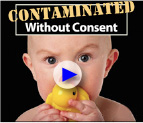Promoting Safer Chemicals and Products
The Workgroup for Safe Markets has developed Five Essential Practices for Retailers, Brand Owners and Suppliers to guide transition to safer chemicals and materials.
We've just released a set of Success Stories about chemical disclosure and safe substition.
Building and Construction
Healthy Building Network works to advance safer materials in the building and construction industry.
The Living Building Challenge is a building certification program that rewards avoidance of hazardous chemicals of concern such as PVC and phthalates.
Businesses
American Sustainable Business Council is a growing network of over 60 business associations across the United States, representing over 165,000 businesses and 300,000 business executives, owners, investors, and others. The ASBC mission is to advance public policies that foster a vibrant, just, and sustainable economy.
The BizNGO Workgroup for Safer Chemicals – a project of Clean Production Action, has published the Guide to Safer Chemicals which features best practice on how to implement the Principles for Safer Chemicals.
Clean Production Action offers trainings on the GreenScreen™ for Safer Chemicals – a chemical hazard assessment tool which is transparent, free and accessible to all.
Green America maintains a directory of businesses working to provide “greener” products.
The Green Chemistry and Commerce Council is a business-to-business forum that advances the application of green chemistry and design for environment across supply chains. It provides an open forum for cross-sector collaboration to share information and experiences about the challenges to and opportunities for safer chemicals and products. They have published numerous reports and other resources that are very useful.
Green chemistry, also known as sustainable chemistry, is the design of chemical products and processes that reduce or eliminate the use or generation of hazardous substances. See the 12 Principles of Green Chemistry
Chemicals in Our Bodies — Biomonitoring Studies
Baby Body Burden: The Pollution in Newborns — Study conducted by Environmental Working Group and Mt. Sinai foundan average of 200 industrial chemicals and pollutants in umbilical cord blood from 10 babies born in August and September of 2004 in U.S. hospitals.
Cosmetic Chemicals in Teenagers — Environmental Working Group study finds an average of 13 hormone-disrupting cosmetic chemicals in the urine of teenage girls.
Hazardous Chemicals in Health Care — Physicians for Social Responsibility (PSR) in partnership with American Nurses Association (ANA) and Health Care Without Harm (HCWH) have released the “Hazardous Chemicals In Health Care” report, detailing the first investigation ever of chemicals found in the bodies of health care professionals.
Is It In Us? — Thirty-five Americans from seven states participated in a national biomonitoringproject in the spring of 2007. This is the broadest non-governmental project of its kind to measure toxic chemicals in the bodies of average Americans.
Mind, Disrupted: How Toxic Chemicals May Change How We Think and Who We Are — A Biomonitoring Project with Leaders of the Learning and Developmental Disabilities Community
National Report on Human Exposure to Environmental Chemicals — Ongoing study by the U.S. Centers for Disease Control and Prevention documenting the presence and levels of over 100 toxic chemicals in the bodies of average Americans
Chemicals Policy Reform
United Nations vote to ban PCP: Alaska Dispatch News
Chemical Policy in States: SAFER States
Cleaning Product Right to Know Act: Women’s Voices for the Earth
Environmental Working Group: updates on chemical policy
Safe Chemicals Act in Congress: Safer Chemicals, Healthy Families
Safe Cosmetics Act and Personal Care Products Act: Campaign for Safe Cosmetics
Chemical Research
ATSDR has many fact-sheets and reports on priority chemicals of concern.
ChemHAT allows users, particularly workers, to investigate the hazards of specific chemicals. The site is free.
Pharos Chemicals and Materials Database offers a comprehensive screen that is user friendly for anyone to assess chemicals for inherent hazards. Subscription is minimal and includes access to their full chemical and building materials database.
Skin Deep — Environmental Working Group’s database of chemicals in cosmetics reviews more than 70,000 personal care products with the top government and academic sources of chemical hazards.
The Endocrine Disruption Exchange (TEDX) Critical Windows of Development - studies of chemicals links to health impacts from inception to birth.
Consumer Goods
Bisphenol A (BPA) in Baby Bottles, Canned Food, and more
Cosmetics Information about toxic products and safer alternatives from the Campaign for Safe Cosmetics
Electronics Take Back Coalition The Electronics TakeBack Coalition (ETBC) promotes green design and responsible recycling in the electronics industry.
Food: What’s On My Food ? Pesticides on food database published by Pesticide Action Network reveals the levels of hazardous chemicals in food and how the public and consumers can take action.
Food Labels: Do you know what you're eating? by the Center for Agriculture and Food Systems.
Healthy Stuff: Healthy Toys, Cars, Children’s Apparel & Accessories. HealthyStuff.org includes test results for over 5,000 products and ranks them according to chemical hazards.
Flame Retardant chemicals in furniture and baby products Fact Sheets, studies, videos, and other information on halogenated flame retardant chemicals exposure, health effects and fire safety issues
School Supplies — Center for Health, Environment & Justice CHEJ’s annual Back-to-School Guide to PVC-free school supplies shows how parents and teachers can identify and find safer PVC-free school supplies for children. A wallet-sized version is also available.
Environmental Health News
Environmental Health News Service — Environmental Health News advances the public’s understanding of environmental health issues by reporting and publishing news stories and providing daily access to news from other media around the world. EHN’s daily e-letter, Above The Fold, is available for free.
Financial/Investors
As You Sow As You Sow promotes environmental and social corporate responsibility through shareholder advocacy, coalition building, and innovative legal strategies.
Green Century Funds Using investments to further environmental protection and profitability
Investor Environmental Health Network (IEHN) IEHN encourages companies to adopt policies to reduce and eliminate toxic chemicals in their products
Green Chemistry and Pollution Prevention
Berkeley Center for Green Chemistry
California Green Chemistry Initiative
ChemSec — European Chemicals Policy
Great Lakes Green Chemistry Network
Lowell Center for Sustainable Production
Michigan Green Chemistry Cleaning House
New York Pollution Prevention Institute
Massachusetts Toxic Use Reduction Institute (TURI)
US EPA Design for the Environment
Health Care Providers
American Nurses Association Environmental health resources for nurses.
Hazardous Chemicals in Health Care Physicians for Social Responsibility (PSR) in partnership with American Nurses Association (ANA) and Health Care Without Harm (HCWH) have released the “Hazardous Chemicals In Health Care” report, detailing the first investigation ever of chemicals found in the bodies of health care professionals.
Health Care Without Harm HCWH works to implement ecologically sound and healthy alternatives to health care practices that pollute the environment and contribute to disease.
Physicians for Social Responsibility Environmental Health Policy Institute
Physicians for Social Responsibility is the largest physician-led organization in the U.S. working to prevent nuclear war and proliferation and to slow, stop and reverse global warming and toxic degradation of the environment.
Practice GreenHealth is the source for environmental solutions for the healthcare sector and lends support to create better, safer, greener workplaces and communities.
Personal Care Products
Campaign for Safe Cosmetics a coalition effort launched in 2004 to protect the health of consumers and workers by securing the corporate, regulatory and legislative reforms necessary to eliminate dangerous chemicals from cosmetics and personal care products.
Skin Deep Database for Hazard Ratings for Cosmetics & Personal Care Products Environmental Working Group database on chemical screening for over 79,000 products
Women’s Voices for the Earth – Safer Cleaning Products WVE is working to ensure that companies are required to list the ingredients in cleaners directly on the label and remove harmful chemicals from their products.
Schools
The Center for Health, Environment & Justice (CHEJ) has lots of resources on vinyl plastic and phthalates in schools, environmentally preferable purchasing, safe school siting and PCB's in schools.
The Healthy Schools Network maintains a healthy schools clearinghouse, cleaning for healthy schools toolkit, and organizes national healthy schools day.
Spanish Resources | Materiales en Español
Jemez Principles
Louville Charter
Videos
Babies on a Soapbox — Why We Need Chemical Reform
Safer Chemicals, Healthy Families, animated short on TSCA Reform
Sam Suds and the Case of PVC, the Poison Plastic
Toxic Chemicals in Products: Financial Risks & Opportunities




